1110 Search Results for Core
December 7, 2012
by Carole Zangari -
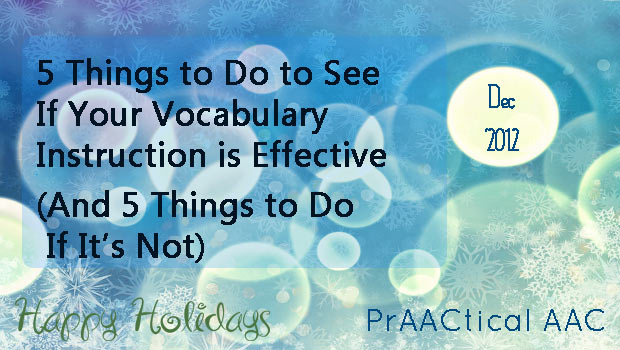
Last month, we talked a lot about semantic intervention with people who are learning AAC. Once we got started, we realized we could have done another whole month on the topic, but we had to move on. We ran out of time before we could really talk about outcome measures. As clinicians, how do we determine whether our therapy is effective? Here are some things to do after you’ve provided high-quality, well-sequenced vocabulary instruction. Make small comprehension checks a regular part of your instruction. Ask the AAC learner to tell you about ___ . Then score their response as objectively as possible (e.g., complete & correct, correct but incomplete, vague, incorrect). You’ll get some real-time feedback and can clarify or re-teach as necessary. Assess in a standardized fashion. Standardized means doing something the same way each time. Set up appropriate assessment tasks that allow you to judge how well the... [Read More...]
December 1, 2012
by Carole Zangari -
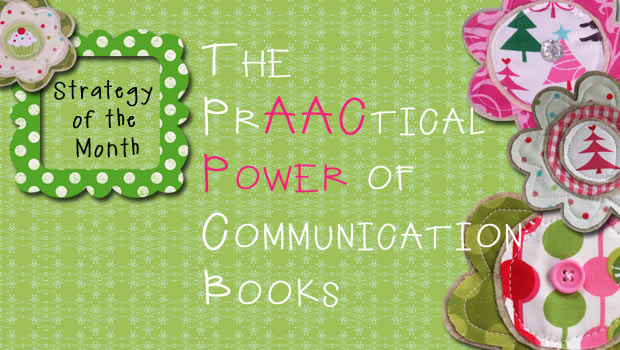
There’s something about the month of December that makes us a bit nostalgic. As we prepare for the holidays, our thoughts drift to the past. Simpler times. Tradition. The way things used to be. And, so, for our Strategy of the Month, we step away from the latest app or fanciest SGD and turn our attention to one of the tried-and-true tools from the past: Communication books. They used to be ubiquitous but now they’re becoming almost a rarity. We’ve decided to focus on them for a couple of reasons, but the main one is to spread the word that it doesn’t take a sizeable budget to give someone access to real language. If you have access to a computer and printer, you can make a really robust communication book for little or no money. It seems so simple: Put some words and pictures in a book. Show someone how... [Read More...]
November 30, 2012
by Carole Zangari -
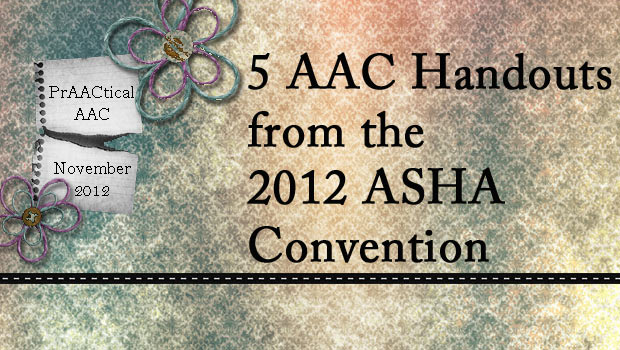
Maybe you didn’t get to the ASHA Convention this year. Or maybe you did, but couldn’t get to all the sessions you had hoped to attend. In either case, we’ve linked to handouts from a number of AAC presentations. Enjoy! AAC in the Common Core State Standards? Karen Erickson, Penny Hatch, Allison Dennis, & Marlene Cummings have your back. This is a project to watch! Janice Light’s presentation on Building Communicative Competence with Individuals who Require AAC: From Research to Effective Practice AAC for Adults With Acquired Neurological Conditions: Today & Tomorrow by David Beukelman, Susan Fager, Julia King, & Karen Hux Analyzing Language Development of Physically Impaired Children Using AAC Devices by Monika Ortloff, Paul Andres, Meher Banajee, & Gail Van Tatenhove Presentation by Cathy Binger and Jennifer Kent Walsh on Selecting Skills to Teach AAC Communication Partners
November 17, 2012
by Carole Zangari -
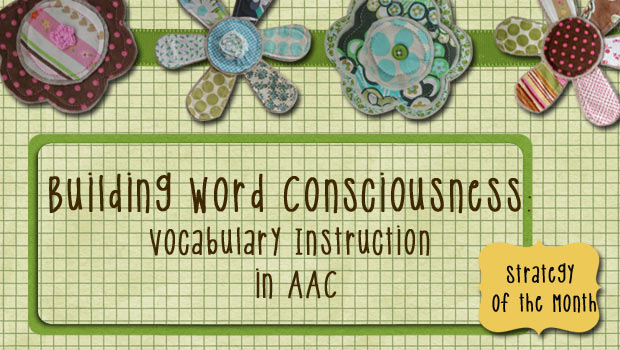
The mind is not a vessel to be filled but a fire to be kindled. Plutarch Last week, Robin discussed some strategies and activities for teaching new words to individuals who are at the earlier stages of language learning. This week, we move ahead and address semantic instruction for individuals who regularly create sentences to express themselves. One of my favorite things about working with AAC learners at this level is the opportunity for having metalinguistic conversations. Getting them to think and talk about language can accelerate their learning. Here are some prAACtical thoughts on how this relates to semantics with a focus on building word consciousness. We’re all familiar with music appreciation and art appreciation. I always think of word consciousness as a sort of like word appreciation. It refers to an awareness that words are the building blocks of language and that they can be examined and manipulated... [Read More...]
November 13, 2012
by Carole Zangari -
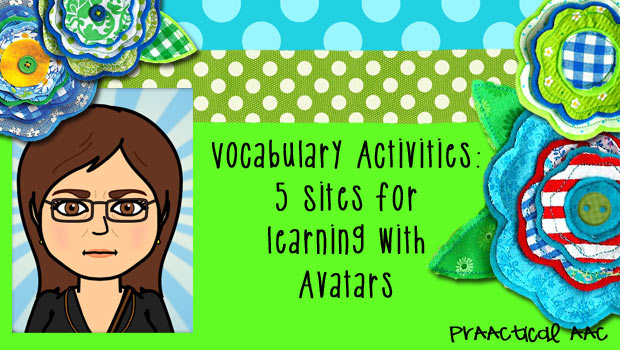
We’re always looking for engaging activities to use to practice words that our AAC friends are learning. For some learners, making avatars can be a great way to do have an authentic reason to use words for body parts and accessories as well as modifiers for size, shape, color, and other things. Plus…Who wouldn’t want an excuse to make a younger, thinner, cuter, or funnier version of themselves?! Here are some sites to check out. Pop Art Pixies: Basic avatar site oriented for girls. Good for using core language, making requests, color & size words. DoppelMe: Easy to use site for making cartoon-like avatars with several opportunities to choose elements, like clothes, hairstyles, and backgrounds. Use words for feelings to select facial expressions. WeeWorld: Another user-friendly site that can be a fun way to use descriptors in making selections to create, dress, and style your avatar. This site’s graphics would... [Read More...]
November 5, 2012
by Robin Parker -
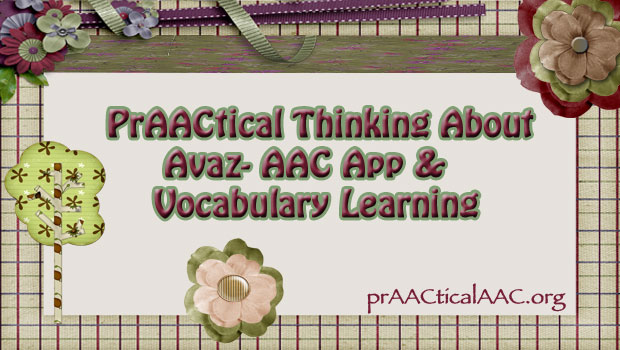
We originally talked about Avaz, the first commercially available AAC app developed in India, back when we introduced PrAACtical AAC in January of 2012. At that time, one of the primary developers, Ajit Narayanan, was recognized by the MIT Technology Review through the prestigious TR35 List, which applauds 35 innovators under 35 years of age. We were congratulating the team at Invention Labs and thinking that they would continue to improve communication for individuals with disabilities throughout 2012. They have succeeded. The Avaz team has worked this year seeking feedback from AAC professionals throughout the world. They have listened and have made many updates to improve the communication and language options of the Avaz App. We thought this was a great time for some follow-up information because many of the modifications and added options relate to vocabulary, which just happens to be our strategy of the month. Pre-loaded vocabulary has... [Read More...]
November 2, 2012
by Carole Zangari -
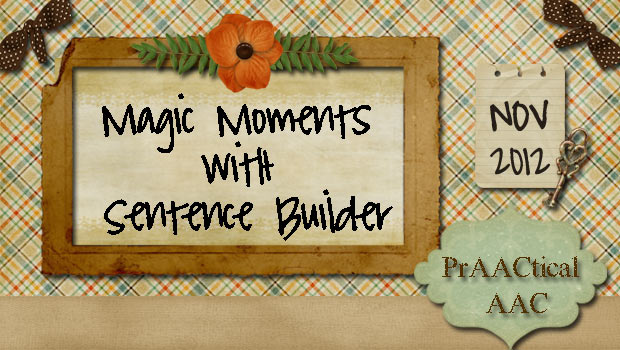
We were lucky enough to snag copies of Sentence Builder by AbiTalk when it was offered for free earlier this year and have had a great time with it. It comes with prepared lessons at two levels and the flexibility to create your own lessons. Here are some ideas for using the ready-made lessons to build language skills in AAC learners. Core Vocabulary: We’re always looking for ways to practice an initial lexicon of basic core words, like I, is, have, and can. These words appear with frequency in Sentence Builder, which makes it a great fit for learners working on that skill. Those of you using this app in a group may find that this offers a great opportunity for differentiating instruction in multi-level groups. Parts of Speech: In AAC therapy, we often focus on the part of speech since that it how many SGDs organize vocabulary. We like... [Read More...]
October 30, 2012
by Carole Zangari -
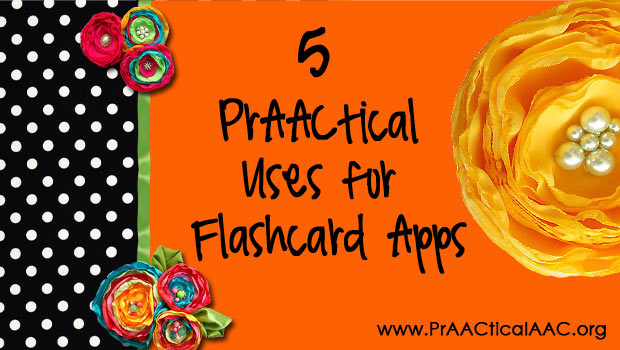
We love AAC intervention that begins and ends with a context that is meaningful to the learner. Not only is contextually relevant therapy more engaging and fun for the learner (thus, easier on the clinician!) but it promotes generalization to real-world contexts. So we’ve never been terribly fond of therapy that uses flash cards, or, more recently, the digital versions on iOS or Android devices. It’s a shame, really. There are a lot of those kinds of apps, and many of them have great graphics. That got us to starting thinking: What could we use them for that improves real communication and AAC learning? PrAACtical Uses for Flashcard Apps Make a Mini Schedule: Lots of people with AAC needs use paper-based picture schedules that depict the activities they do throughout the day. A flashcard app could be used in conjunction with those to show the steps or parts of an... [Read More...]
October 9, 2012
by Carole Zangari -
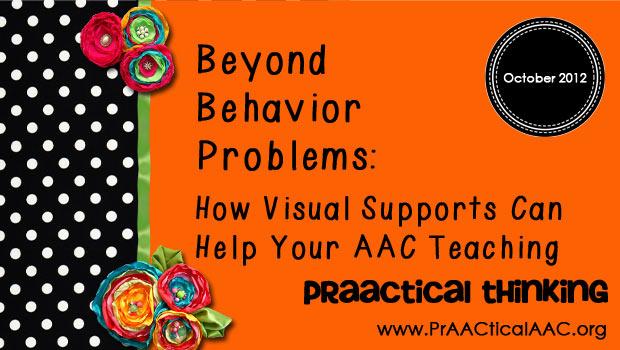
Visual supports are not just for people with behavioral challenges. In this post, we share some ideas of using visual schedules and other supports to enhance comprehension and language learning. Let’s look put this into a clinical context. Marvin is a high school student with intellectual disabilities and cerebral palsy who is learning to use a high tech SGD. He is a personable young man who engages easily and comes to each session with a ‘ready to learn’ mindset. Most of Marvin’s goals revolve on learning to build sentences using core words. Although he has very limited literacy skills, he really, really wants to learn word prediction. This presented a bit of a dilemma, as I typically don’t begin to teach word prediction until spelling skills are approaching the third grade level. Marvin has some terrific splinter skills but his overall spelling skills are probably around the mid-first grade level.... [Read More...]
September 28, 2012
by Carole Zangari -
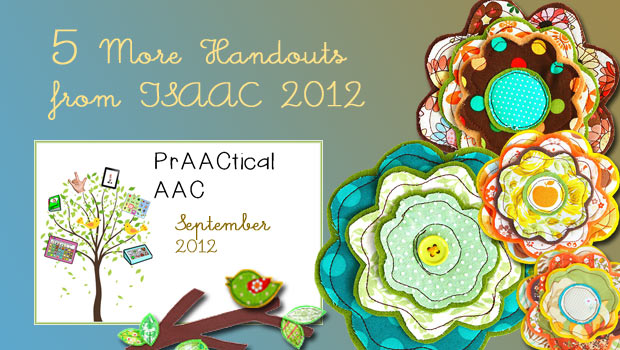
In past posts, we shared links to some handouts from the ISAAC 2012 Biennial Conference in Pittsburgh. While it is great for those of us who attended but couldn’t get to every presenter we wanted to hear, the main idea was to help spread the awesome content to those of you who couldn’t be there. Here are some others that may be of interest. Creating a Core Vocabulary for a Common Core Curriculum by Karen Erickson, Penelope Hatch, Allison Dennis, & Marlene Cummings Baby Talk/Kid Talk PWUAAC Talk to Little Ones! by Krista Howard, Kaitlyn Graham, & Caroline Musselwhite Evaluating Preferred Augmentative and Alternative Communication Strategies for Patients in Long Term Health Care Hospitals by Susan Fager, Jenna LeDoux, & David Beukelman Prompting: A Cautionary Tale of Use, Misuse & Abuse by Jane Korsten & Terry Foss Supporting Linguistic Skills Through iDevices: Cool Tricks with New Applications by Caroline Musselwhite,... [Read More...]








